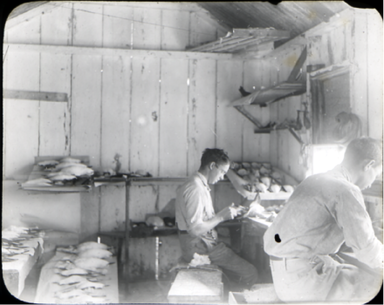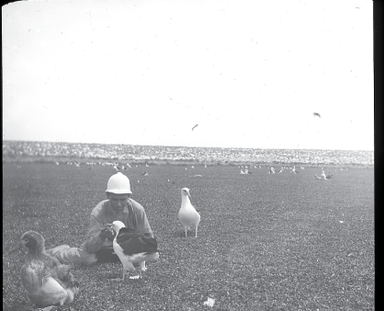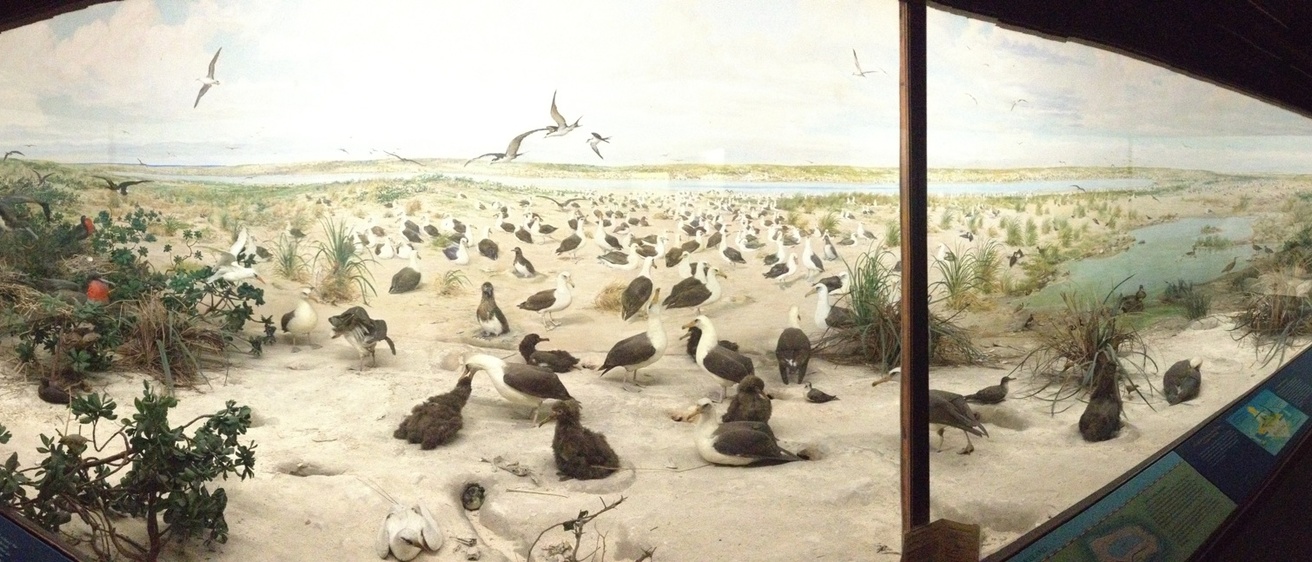Visitors to the University of Iowa Museum of Natural History can venture through a narrow passageway at the western end of Hageboeck Hall of Birds and find themselves transported 5,000 miles from Iowa City to Laysan Island, a western outpost of the Hawaiian Islands and bird sanctuary.
The Laysan Island Cyclorama is a 360-degree re-creation of the sights and sounds of the island at its heyday — 8 million birds of 22 different species on a landmass of 1.5 square miles.
The museum will be celebrating the 100th anniversary of this unusual exhibit with a celebratory reception from 7 to 9 p.m. Friday, June 13, in the Hageboeck Hall of Birds. The event is free and open to the public. Light desserts will be served, and a cash bar will be available.
“We’re pleased that we celebrate this landmark anniversary of this extraordinary depiction of an extraordinary place with friends and supporters from throughout the community,” says Trina Roberts, associate director of the museum.
The story of how the exhibit came to be is also extraordinary. In 1902 Charles Nutting, director of the UI Museum of Natural History, first traveled to Laysan as a scientific advisor to a government expedition. He was so inspired by the multitudes of terns, albatrosses, finches, boobies, and other birds that he vowed to re-create the scene in Iowa City.
“It was the good fortune of the writer to visit this great metropolis of oceanic birds…and never has he witnessed a more impressive scene,” Nutting wrote. “Nor does it require the standpoint of the naturalist to arouse enthusiasm in view of this amazing spectacle; for no one, however far removed from that point of view, could possibly contemplate this assemblage of avian life without being profoundly moved.”

Nutting led the UI in a nine-year fundraising campaign. Laysan frequently made headlines in The Daily Iowan. In 1909, the football team even performed a skit at a lecture on Hawaii to raise funds for the trip. In 1911, Nutting sent Homer Dill, who managed the museum’s bird and mammal collections, along with UI students Horace Young and Clarence Albrecht and muralist Charles Corwin back to Laysan to gather specimens for an exhibit.
The party found the island very different from the paradise Nutting had described almost a decade earlier. In addition to evidence of feather poaching, rabbits introduced by a guano miner in 1903 had overwhelmed the island, stripping it of its vegetation and decimating insect populations. Lacking food and shelter, some seabirds took flight to other islands, but land birds were unable to fly the long distances to other islands.

Despite this, Dill returned to Iowa City with 36 large crates of specimens, including plants and sand. Museum studies students handcrafted thousands of wax leaves for the display, and Corwin painted a 138-foot-long backdrop. When it opened, the cyclorama was one of the first in the world to feature a natural theme and is one of a handful of cycloramas still existing today.
“In looking at it from without the glass balcony the effect is that of standing on the shore of this avian resort,” The Iowa Alumnus magazine reported in June 1914. “The island is mostly birds, and groups and nesting birds are to be seen everywhere, some flying and some on the ground. Soil and rocks have been transported so that the actual beach is really present. It breaks off into the painted background with such reality that the observer can hardly tell which is real and which is painted.”
In 1912, UI sophomore Albert Bailey returned to the island, but ran out of poison and ammunition, barely affecting the rabbit population. In 1923 the Tanager Expedition killed the last of the rabbits on Laysan Island — too late for the Laysan rail, Laysan honeycreeper and Laysan millerbird, which went extinct due to the devastation. Two more species, the Laysan finch and the Laysan duck, remain endangered.
No major modifications have been made to the cyclorama, but renovations in the early 2000s included the addition of interpretive signs and a soundtrack of bird calls of all 22 living and extinct species that have inhabited the island. While museum staff have hand-cleaned parts of the background mural, no major conservation work has been done. A 2003 grant funded a conservation assessment, and the museum, with the support of the Iowa City Bird Club, has held several fundraising efforts to finance the work that needs to be done.
The exhibit Wonderful Preserve: A Century of Recovery on Laysan Island, opening at the UI's Old Capitol Museum on Aug. 14, will investigate the continuing recovery and current scientific work on the island, telling the next chapter in the story of Laysan.
“Nutting, Dill and their colleagues had an ambitious, forward thinking idea for an exhibit that still amazes visitors a century later,” says Roberts. “They witnessed an ecological catastrophe they couldn’t stop but could use to educate students and visitors—which the exhibit continues to do today.”
Individuals with disabilities are encouraged to attend all UI-sponsored events. If you are a person with a disability who requires a reasonable accommodation in order to participate in this program, contact the Pentacrest Museums in advance at 319-335-2010.
For more information on the Museum of Natural History, call 319-335-0606 or visit the Museum of Natural History website.
